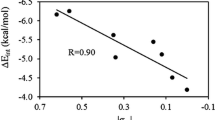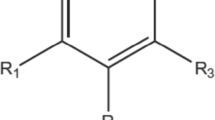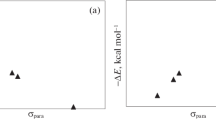Abstract
Interplay between CH…π and hydrogen bond interactions of benzamide has been investigated by quantum mechanical calculations. The effect of the substituents on geometrical parameters has also been studied at the B3LYP level with 6-311++G(d,p) basis set. The electron-withdrawing substituents enhance the total interaction energy of the complexes. The results indicated that the cooperativity of interactions leads to extra stability of the ternary complexes. The CH…π interaction and the hydrogen bond energies have been estimated using the electron densities calculated by the atoms in molecules (AIM) method at hydrogen bond critical points. The strength of hydrogen bonding increases in the presence of CH…π interaction in the ternary complexes. The effect of CH…π interaction on the hydrogen bond interaction has also been studied by the natural bond orbital, AIM and the molecular electrostatic potential analyses.





Similar content being viewed by others
References
Nagahama S, Inoue K, Sada K, Miyata M, Matsumoto A (2003) Two-dimensional hydrogen bond networks supported by CH/π interaction leading to a molecular packing appropriate for topochemical polymerization of 1,3-diene monomers. Cryst Grow Des 3:247–256
Saigo K, Kobayashi Y (2007) The role of CH/π interaction in the stabilization of less-soluble diastereomeric salt crystals. Chem Rec 7:47–56
Clark TE, Makha M, Sobolev AN, Dalgarno SJ, Atwood JL, Raston CL (2007) Structural diversity of methyl-substituted inclusion complexes of Calix[5] arene. Cryst Grow Des 7:2059–2065
Meyer EA, Castellano RK, Diederich F (2003) Interactions with aromatic rings in chemical and biological recognition. Angew Chem Int Ed Engl 42:1210–1250
Mahesh Kumar R, Elango M, Parthasarathi R, Vijay D, Subramanian V (2012) The role of C–H…π interaction in the stabilization of benzene and adamantane clusters. J Chem Sci 124:193–202
Nishio M (2011) The CH/π hydrogen bond in chemistry conformation, supramolecules, optical resolution and interactions involving carbohydrates. Phys Chem Chem Phys 13:13873–13900
Ramanathan K, Shanthi V, Sethumadhavan R (2010) Exploring the role of C–H…π interactions on the structural stability of membrane proteins. Int J Pharm Bio Sci 6:1–14
Kee Kang Y, Jin Byun B (2012) Strength of CH…π interactions in the C-terminal subdomain of villin headpiece. Biopolymers 97:778–788
Brandl M, Weiss MS, Jabs A, Suhnel J, Hilgenfeld R (2001) C–H…pi-interactions in proteins. J Mol Biol 307:357–377
Tayubi IA, Sethumadhavan R (2011) Theoretical understanding of C-H…π interaction and their distribution in immunoglobulin proteins-insilco geometrical approach. Int J Pharm Pharm Sci 3:212–218
Ramanathan K, Shanthi V, Sethumadhavan R (2009) Significance of CH/π interactions on the stability of therapeutic proteins. Struct Biol 3:1–10
Raju RK, Burton NA, Hillier IH (2010) Modelling the binding of HIV-reverse transcriptase and nevirapine: an assessment of quantum mechanical and force field approaches and predictions of the effect of mutations on binding. Phys Chem Chem Phys 12:7117–7125
Ozawa T, Okazaki K, Kitaura K (2011) Importance of CH/π hydrogen bonds in recognition of the core motif in proline-recognition domains: an Ab initio fragment molecular orbital study. J Comput Chem 32:2774–2782
Černy JI, Kabelač M, Hobza P (2008) Double-helical → ladder structural transition in the B-DNA is induced by a loss of dispersion energy. J Am Chem Soc 130:16055–16059
Tatko CD, Waters ML (2004) Comparison of C–H···π and hydrophobic interactions in a β-hairpin peptide: impact on stability and specificity. J Am Chem Soc 126:2028–2034
Karthikeyan S, Venkatnarayan R, Mishra BK (2013) Influence of the substituents on the CH…π interaction: benzene–methane complex. J Phys Chem A 117:6687–6694
Takahashi O, Kohno Y, Saito K (2003) Molecular orbital calculations of the substituent effect on intermolecular CH/π interaction in C2H3X–C6H6 complexes (X = H, F, CL, Br, and OH). Chem Phys Lett 378:509–515
Tsuzuki S, Honda K, Uchimaru T, Mikami M, Tanabe K (2002) The interaction of benzene with chloro- and fluoromethanes: effects of halogenation on CH/π interaction. J Phys Chem A 106:4423–4428
Mishra BK, Karthikeyan S, Ramanathan V (2012) Tuning the C–H···π interaction by different substitutions in benzene–acetylene complexes. J Chem Theory Comput 8:1935–1942
Hohenstein EG, Duan J, Sherrill CD (2011) Origin of the surprising enhancement of electrostatic energies by electron-donating substituents in substituted sandwich benzene dimers. J Am Chem Soc 133:13244–13247
Ringer AL, Sherrill CD (2009) Substituent effects in sandwich configurations of multiply substituted benzene dimers are not solely governed by electrostatic control. J Am Chem Soc 131:4574–4575
Shibasaki K, Fujii A, Mikami N, Tsuzuki S (2007) Magnitude and nature of interactions in benzene-X (X = ethylene and acetylene) in the gas phase: significantly different CH/π interaction of acetylene as compared with those of ethylene and methane. J Phys Chem A 111:753–758
Tsuzuki S, Honda K, Uchimaru T, Mikami M, Fujii A (2006) Magnitude and directionality of the interaction energy of the aliphatic CH/π interaction: significant difference from hydrogen bond. J Phys Chem A 110:10163–10168
Lin B, Cheng C, You Z, Hsu C (2011) The role of CH–π interaction in the charge transfer properties in tris(8-hydroxyquinolinato)aluminium(III). Phys Chem Chem Phys 13:20704–20713
Gung BW, Amicangelo JC (2006) Substituent effects in C6F6–C6H5X stacking interactions. J Org Chem 71:9261–9270
Tsuzuki S, Honda K, Uchimaru T, Mikami M, Tanabe K (2000) The magnitude of the CH/π interaction between benzene and some model hydrocarbons. J Am Chem Soc 122:3746–3753
Mignon P, Loverix S, Proft FD, Geerlings P (2004) Influence of stacking on hydrogen bonding: quantum chemical study on pyridine-benzene model complexes. J Phys Chem A 108:6038–6044
Mignon P, Loverix S, Geerlings P (2005) Interplay between π–π interactions and the H-bonding ability of aromatic nitrogen bases. Chem Phys Lett 401:40–46
Cosi C, Chopin P, Marien M (1996) Benzamide, an inhibitor of poly (ADP-ribose) polymerase, attenuates methamphetamine-induced dopamine neurotoxicity in the C57B1/6 N mouse. Brain Res 735:343–348
Brethous L, Garcia-Delgado N, Schwartz J, Bertrand S, Bertrand D, Reymond JL (2012) Synthesis and nicotinic receptor activity of chemical space analogues of N-(3R)-1-azabicyclo[2.2.2]oct-3-yl-4-chlorobenzamide (PNU-282,987) and 1,4-diazabicyclo [3.2.2] nonane-4-carboxylic Acid 4-bromophenyl ester (SSR180711). J Med Chem 55:4605–4618
Mao W, Ning M, Liu Z, Zhu Q, Leng Y, Zhang A (2012) Design, synthesis, and pharmacological evaluation of benzamide derivatives as glucokinase activators. Bio Med Chem 20:2982–2991
Momeni Z, Ebrahimi A (2015) Investigation of the effect of π–π stacking interaction on the properties of –CONH2 functional group of benzamide. Struct Chem. doi:10.1007/s11224-015-0615-7
Frisch MJ, Trucks GW, Schlegel HB, Scuseria GE, Robb MA, Cheeseman JR, Scalmani G, Barone V, Mennucci B, Petersson GA, Nakatsuji H, Caricato M, Li X, Hratchian HP, Izmaylov AF, Bloino J, Zheng G, Sonnenberg JL, Hada M, Ehara M, Toyota K, Fukuda R, Hasegawa J, Ishida M, Nakajima T, Honda Y, Kitao O, Nakai H, Vreven T, Montgomery JA Jr, Peralta JE, Ogliaro F, Bearpark M, Heyd JJ, Brothers E, Kudin KN, Staroverov VN, Kobayashi R, Normand J, Raghavachari K, Rendell A, Burant JC, Iyengar SS, Tomasi J, Cossi M, Rega N, Millam JM, Klene M, Knox JE, Cross JB, Bakken V, Adamo C, Jaramillo J, Gomperts R, Stratmann RE, Yazyev O, Austin AJ, Cammi R, Pomelli C, Ochterski JW, Martin RL, Morokuma K, Zakrzewski VG, Voth GA, Salvador P, Dannenberg JJ, Dapprich S, Daniels AD, Farkas O, Foresman JB, Ortiz JV, Cioslowski J, Fox DJ (2009) Gaussian09, Revision C.01. Gaussian Inc., Wallingford
Boys SB, Bernardi F (1970) The calculation of small molecular interactions by the differences of separate total energies. Some procedures with reduced errors. Mol Phys 19:553–566
Biegler Konig FW, Schonbohm J, Bayles D (2001) Software news and updates AIM2000. J Comput Chem 22:545–559
Ebrahimi A, Habibi Khorasani SM, Delarami H (2009) Estimation of individual binding energies in some dimers involving multiple hydrogen bonds using topological properties of electron charge density. Chem Phys 365:18–23
Glendening ED, Reed AE, Carpenter JE, Weinhold F, NBO Version 3.1
Scrocco E, Tomasi J (1978) Electronic molecular structure, reactivity and intermolecular forces: an euristic interpretation by means of electrostatic molecular potentials. Adv Quantum Chem 11:115–193
Politzer P, Laurence PR, Jayasuriya K (1985) Molecular electrostatic potentials: an effective tool for the elucidation of biochemical phenomena. Environ Health Persp 61:191–202
Murray JS, Paulsen K, Politzer P (1994) Molecular surface electrostatic potentials in the analysis of non-hydrogen-bonding noncovalent interactions. Proc Indian Acad Sci (Chem Sci) 106:267–275
Naray-Szabo G, Ferenczy GG (1995) Molecular electrostatics. Chem Rev 95:829–847
Politzer P, Murray JS (1999) Representation of condensed phase properties in terms of molecular surface electrostatic potentials. Trends Chem Phys 7:157–168
Politzer P, Murray JS (2001) Computational prediction of condensed phase properties from statistical characterization of molecular surface electrostatic potentials. Fluid Phase Equilib 185:129–137
Wang DL, Shen HT, Gu HM, Zhai YC (2006) Ab initio studies on the molecular electrostatic potential of C50. J Mol Struct (THEOCHEM) 776:47–51
Luque FJ, Orozco M, Illas F, Rubio J (1991) Effect of electron correlation on the electrostatic potential distribution of molecules. J Am Chem Soc 113:5203–5211
Murray JS, Ranganathan S, Politzer P (1991) Correlations between the solvent hydrogen bond acceptor parameter.beta. and the calculated molecular electrostatic potential. J Org Chem 56:3734–3737
Hagelin H, Brinck T, Berthelot M, Murray JS, Politzer P (1995) Family-independent relationships between computed molecular surface quantities and solute hydrogen bond acidity/basicity and solute-induced methanol O-H infrared frequency shifts. Can J Chem 73:483–488
Murray JS, Peralta-Inga Z, Politzer P, Ekanayake K, Lebreton P (2001) Computational characterization of nucleotide bases: molecular surface electrostatic potentials and local ionization energies, and local polarization energies. Int J Quantum Chem 83:245–254
Hussein W, Walker CG, Peralta-Inga Z, Murray JS (2001) Computed electrostatic potentials and average local ionization energies on the molecular surfaces of some tetracyclines. Int J Quantum Chem 82:160–169
Politzer P, Murray JS, Concha MC (2002) The complementary roles of molecular surface electrostatic potentials and average local ionization energies with respect to electrophilic processes. Int J Quantum Chem 88:19–27
Lu T (2013) Multiwfn: a multifunctional wave function analyzer, version 3.2
Kar T, Scheiner S (2006) Cooperativity of conventional and unconventional hydrogen bonds involving imidazole. Int J Quantum Chem 106:843–851
Solimannejad M, Massahi S, Scheiner S (2009) Existence and characterization of HOO–HOOOH radical-molecule complexes: a computational study. J Mol Struc (THEOCHEM) 913:50–53
Krygowski TM (1993) Crystallographic studies of inter- and intramolecular interactions reflected in aromatic character of pi.-electron systems. J Chem Inf Comput Sci 33:70–78
Poater J, Sola M, Viglione RG, Zanasi R (2004) Local aromaticity of the six-membered rings in pyracylene. A difficult case for the NICS indicator of aromaticity. J Org Chem 69:7537–7542
Hammett LP (1935) Some relations between reaction rates and equilibrium constants. Chem Rev 17:125–136
Cozzi F, Ponzini F, Annunziata R, Cinquini M, Siegel JS (1995) Polar interactions between stacked π systems in fluorinated 1,8-diarylnaphthalenes: importance of quadrupole moments in molecular recognition. Angew Chem Int Ed Engl 34:1019–1020
Zhu W, Tan X, Shen J, Luo X, Cheng F, Mok PC, Ji R, Chen K, Jiang H (2003) A quantum chemistry study using density-functional theory and morokuma decomposition methods. J Phys Chem A 107:2296–2303
Author information
Authors and Affiliations
Corresponding author
Electronic supplementary material
Below is the link to the electronic supplementary material.
Rights and permissions
About this article
Cite this article
Momeni, Z., Ebrahimi, A. The influence of CH…π interaction on hydrogen bonding ability of –CONH2 functional group of benzamide. Struct Chem 27, 1199–1209 (2016). https://doi.org/10.1007/s11224-016-0745-6
Received:
Accepted:
Published:
Issue Date:
DOI: https://doi.org/10.1007/s11224-016-0745-6




